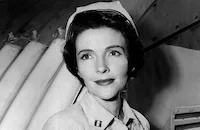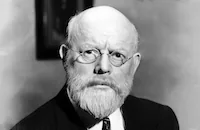The Next Voice You Hear

Brief Synopsis
Cast & Crew
William A. Wellman
James Whitmore
Nancy Reagan
Gary Gray
Lillian Bronson
Art Smith
Film Details
Technical Specs

Synopsis
Joe and Mary Smith and their young son Johnny live in a modest home in a suburban Los Angeles neighborhood. The Smiths lead simple lives defined by mostly their daily routines: Joe works hard at his steady job at the Ajax Aircraft Plant and Johnny attends school and delivers newspapers, while Mary, who is nine months pregnant, is a homemaker. One evening, while Mary is helping Johnny with his homework, Joe turns on the radio in the living room, expecting to hear his favorite program. However, instead of the usual programming, Joe hears a voice that identifies itself as the voice of God. Though perplexed by the voice and initially believing it to be a hoax, Joe later tells Mary that he heard the voice tell him that God will be broadcasting on the radio for the next few days. The following morning, Joe reads in the newspaper that three thousand people reported hearing a strange voice on the radio the previous night, and that they all heard the same thing he heard. Later that evening, when Joe returns home from his bowling game, Mary tells him that she heard the voice of God on the radio and that it said that God was planning to perform miracles. As the government begins an investigation into the mysterious radio voice, which is now being heard all over the world, the talk of the town is the voice of God. The next time that God addresses the world, a fiery thunderstorm suddenly advances upon the city, sending Mary and Johnny into Joe's arms for comfort. Joe tries to calm them by insisting that the storm was a coincidence, but Mary is not convinced. As all scientific attempts to explain the voice fail, people all over the world begin to conclude that the voice really is God. Joe eventually decides that the voice is real, too, and that he has been given a sign from God to respect his boss, Fred Brannan, and to be kinder to Mary's sister, Ethel. On the fourth consecutive day of God's radio broadcasts, the world is instructed to perform miracles of kindness and peace. The following day, while drinking in a bar with his friend Mitch, an intoxicated Joe has a epiphany and realizes that the time he spends with Mitch in bars is wrong. Before staggering out of the bar, Joe tells Mitch that he is the "voice of evil." When Joe returns home, Johnny sees his father drunk for the first time and is ashamed. Joe quickly reforms his ways and, the following day, apologizes to Ethel for his past behavior. Johnny, however, becomes disillusioned and runs away from home. Joe finds his son at Fred's house, and their frank discussion leads to a reconciliation. The next day, the Smiths attends a special church service to hear the voice of God speak on the radio, but on that day, the seventh day, no voice is heard. Their minister concludes that God must be resting, and with that pronouncement, Mary goes into labor. Hours later, Mary gives birth to a baby girl, and Joe and Johnny are overjoyed.

Director

William A. Wellman
Cast

James Whitmore

Nancy Reagan

Gary Gray

Lillian Bronson
Art Smith

Tom D'andrea

Jeff Corey
George Chandler

Douglas Kennedy
Tim Hawkins
Jim Hayward
Thomas Brown Henry

Marjorie Hoshelle
Milton Corey Sr.
Mary Bear
Donald Kerr
Mickey Little

Frankie Darro
Grace Lord
Fred Hoose
William H. Vedder

Howard Mitchell
Michael Barret
Helen Eby-rock
Rhea Mitchell
Donna Boswell
Sherry Jackson
Tommy Myers
Douglas Carter
Bob Alden
Louis Merrill
Chester Huntley
Cecil Brown
Wilson Wood
Lyle Clark
Jack Sterling
Billy Bletcher
Jim Pierce
Frank Gerstle
John Mckee
Rush Williams
Frank Cady
Dwight Martin
Eula Guy
Crew
Neal Beckner
John Dunning
Joel Freeman
Bill Gale
Cedric Gibbons
Greydon Gilmer
Edward Gubbell
Ralph S. Hurst
Eddie Imazu
Conrad Kahn
William Mellor
Leo Monlon
C. A. Philbrick
David Raksin
Ruby Rosenberg
Dore Schary
Dore Schary
Charles Schnee
Douglas Shearer
Edwin B. Willis

Photo Collections
Film Details
Technical Specs

Articles
The Next Voice You Hear - The Next Voice You Hear
Although Voice is not a sequel, its leading characters are borrowed from an earlier MGM film, Joe Smith, American (1942). James Whitmore plays Joe, the dad who toils at an airplane factory, and Gary Gray completes the family unit as son Johnny. It is no coincidence, given the religious tone, that the parents are named Joe and Mary, and that the wife is pregnant. Like other listeners around the world, the Smiths are at first frightened, then inspired by the overriding theme of "Love thy Neighbor" as God takes over the airwaves on six consecutive evenings. A young, uncredited Chet Huntley is one of the radio announcers.
The movie was the pet project of Dore Schary, MGM's chief of production from 1947 to 1956. A champion of earnest "message pictures," Schary lavished more attention on this modestly budgeted film than on some of the studio's more lavish productions. William A. Wellman directs with a typically keen eye for no-nonsense characterization, helping to soften the film's potential for preachiness.
The Next Voice You Hear marked Davis's first leading role at MGM, where she was a contract player from 1949 to 1952. Although she never achieved true star status, Davis had her own dressing room on the studio lot, and her name appeared in giant letters on the marquee of Radio City Music Hall when Voice had its premiere there on June 29, 1950. Her marriage to Reagan came two years later.
Producer: Dore Schary
Director: William A. Wellman
Screenplay: Charles Schnee, from story by George Sumner Albee
Cinematography: William Mellor
Original Music: David Raksin
Editing: John D. Dunning
Art Directors: Cedric Gibbons, Eddie Imazu
Principal Cast: James Whitmore (Joe Smith), Nancy Davis (Mrs. Mary Smith), Gary Gray (Johnny Smith), Lillian Bronson (Aunt Ethel), Art Smith (Mr. Brannan), Tom D'Andrea (Hap Magee).
BW-83m. Closed captioning.
by Roger Fristoe

The Next Voice You Hear - The Next Voice You Hear
Quotes
Trivia
Notes
The following written Biblical passage appears above the title in the onscreen credits: "'...neither was the Word of the Lord yet revealed unto him.' First Book of Samuel, Chapter III, Verse 7." The closing credits contain the following passage: "'In the begining was the word; and the Word was with God: and the Word was God.' John, Chapter I, Verse I." Seven intertitles appear in the film and divide the story into episodes representing the days of the week. The Next Voice You Hear was one of twelve films that Dore Schary personally supervised during his tenure as Vice President in Charge of Production at M-G-M. According to contemporary sources, Schary, who took his post in June 1948, used the film as an object lesson in frugal budgeting for the M-G-M producers under his supervision. A March 1950 Daily Variety news item noted that the film was budgeted at $500,000, approximately half the cost of the average production at M-G-M at the time. Various contemporary news items indicate that the production was placed on a three-week shooting schedule but was completed in a mere fourteen days, at a final cost of $460,000. Schary wrote a book about picture, entitled Case History of a Movie, which traced the progress of the production from a short story to a completed film. The publication of Schary's book was slated to coincide with the release of the film.















